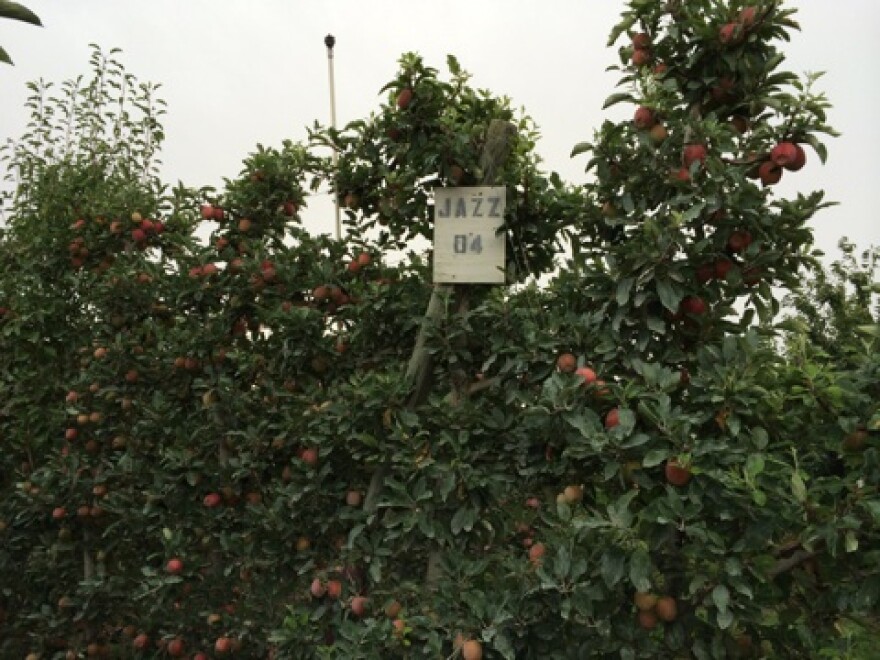Maybe you remember those glossy Red Delicious Washington apples they served in your grade school cafeteria. Well, Washington growers are expecting a record crop of apples this year, but not of Red Delicious. Most American consumers have moved on and growers are doing their best to keep up.
Grower Rob McCormick stoops to examine a knotty tree trunk in an apple orchard in Selah, Washington. “You see right here ?” he says. “These had been Red Delicious. Then we cut this down to a stump and grafted in the Galas.”
Washington growers are expecting a record crop of apples this year, but not of Red Delicious: most American consumers have moved on.
At the height of their popularity, Red Delicious accounted for more than two thirds of Washington apples. Today, the variety represents just over a quarter of the fruit grown here. Prices have fallen dramatically. Frequently now, old varieties like red and golden delicious cost more to produce than you can sell them for.
As McCormick has it, “Everything is worth something. But sometimes that something is less than nothing.” Like many growers, there are years he lets his harvest fall to the ground. “Is that an easy thing to do? Can I be dispassionate about it? No. I produced these things…it would be a hard thing to waste ‘em.’
Galas are originally from New Zealand. In 30 years, they have taken the place of Red Delicious as America’s most popular apple. But McCormick says there are still profitable years for Reds too. He has converted some Reds to Galas, he says, “but we didn’t do the whole place. That was more of a gamble than I wanted to take.”
In 35 years growing apples, McCormick says he’s seen more than one fellow grower invest heavily in a new variety and end up taking a loss. Reds are “cheap” and reliable to grow – they don’t require a lot of special treatment.
He tugs at a Red Delicious dangling from a branch. “When that is mature,” he says, “it will be as good an eating apple as you can find.”
David Nelley, Director of Apple and Pear Operations for apple marketing firm Oppenheimer, disagrees. “Reds came out a long time ago,” he says,” and I dare say expectations have risen since then.”
“The specifications that some of the retailers require from us, have changed,” he explains. Today’s apples are sweeter and more crisp. They have a longer shelf life. First there was Gala, then Fuji, and now, Honeycrisp.
Nelley calls it “the rockstar of the apple world in North America right now.” Last year, a box of Honeycrisp apples fetched nearly three times as much as a box of Red Delicious.
But as more and more growers get in on the action, quality control becomes key. Somewhere, Nelley says, “There is a consumer who walks down to their store, picks up a Honeycrisp, and they may have one that was picked a little bit too early, or grown in the wrong place during this gold rush of the Honeycrisp years. So that person is gonna think, ‘Wow, that’s not what I remember a Honeycrisp tasted like.’”When that happens too many times, prices will fall.

Some growers, like Dave Allan, are trying a new strategy to avoid this cycle of boom and bust.
Stepping down from his pickup truck into an orchard south of Yakima, Allan plucks a rosy-hued apple from the tree and begins to extol its virtues: “Now, Pacific Rose is a big, sweet apple. And it will get a brighter red. It’s just a beautiful apple.”
“What’s neat about this Pacific Rose,” Allan says, using a pocket knife to cut himself a slice, “is after storage, you get this kind of aroma that comes out of it.”
All these qualities make Allan think Pacific Rose could be the next Honeycrisp. But it’s not his only bet. Aided by DNA sequencing and advanced computing, the number of new varieties is exploding.
“Envy was the last one that came to us,” Allan explains. “It came as a number, and I don’t even remember the number now.”
Both Envy and Pacific Rose are known as “club varieties”: you can only grow them if you’re part of the club. What that means is that breeders trademark their new creations, and license the right to grow and sell them to hand-picked partners. Then, together, they invest a lot in building a new brand, and they limit production.
Suzanne Wolter, of Rainier Fruit, explains: “You want to make sure that you don’t plant so many trees that you’re not able to sell the fruit when it actually gets to the market.”
Wolter oversees marketing operations for Rainier, one of Washington State’s largest apple producers. She says trademark protection allows companies to invest more in marketing their new proprietary varieties. One goal is to ensure that new varieties avoid the fate of an apple called Cameo. When Cameo was introduced, “Growers were getting more yield and we were packing more fruit every single year,” Wolter says. But, consumers didn’t buy it! People didn’t know about it.”
With dozens of new varieties and a resurgence of heirloom and regional ones competing for market share, there’s a long list of also-rans in today’s apple world: delicious, but hard to sell. Rob McCormick singled out Braeburn and Firmgold, which he calls a “superior apple.”
“They’re firmer, they store better, look how big they get,” McCormick says, marveling at the sight of an overloaded Firmgold tree nearing harvest. “Look at the size of that thing! Now, how can that not be worth something?”
Though McCormick says it’s a bit arbitrary which varieties ultimately win out for shelf space in the grocery store, there’s not much to do about it. “You can’t tell people what they want,” he says. What they want is what they want. You either grow what they want, or find another business.”
Copyright 2014 Northwest Public Radio




